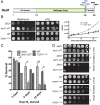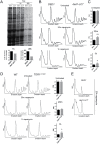The DEAD-box RNA helicase Ded1 has a role in the translational response to TORC1 inhibition
- PMID: 31141444
- PMCID: PMC6743465
- DOI: 10.1091/mbc.E18-11-0702
The DEAD-box RNA helicase Ded1 has a role in the translational response to TORC1 inhibition
Abstract
Ded1 is a DEAD-box RNA helicase with essential roles in translation initiation. It binds to the eukaryotic initiation factor 4F (eIF4F) complex and promotes 48S preinitiation complex assembly and start-site scanning of 5' untranslated regions of mRNAs. Most prior studies of Ded1 cellular function were conducted in steady-state conditions during nutrient-rich growth. In this work, however, we examine its role in the translational response during target of rapamycin (TOR)C1 inhibition and identify a novel function of Ded1 as a translation repressor. We show that C-terminal mutants of DED1 are defective in down-regulating translation following TORC1 inhibition using rapamycin. Furthermore, following TORC1 inhibition, eIF4G1 normally dissociates from translation complexes and is degraded, and this process is attenuated in mutant cells. Mapping of the functional requirements for Ded1 in this translational response indicates that Ded1 enzymatic activity and interaction with eIF4G1 are required, while homo-oligomerization may be dispensable. Our results are consistent with a model wherein Ded1 stalls translation and specifically removes eIF4G1 from translation preinitiation complexes, thus removing eIF4G1 from the translating mRNA pool and leading to the codegradation of both proteins. Shared features among DED1 orthologues suggest that this role is conserved and may be implicated in pathologies such as oncogenesis.
Figures







Similar articles
-
Yeast Ded1 promotes 48S translation pre-initiation complex assembly in an mRNA-specific and eIF4F-dependent manner.Elife. 2018 Oct 3;7:e38892. doi: 10.7554/eLife.38892. Elife. 2018. PMID: 30281017 Free PMC article.
-
Genome-wide analysis of translational efficiency reveals distinct but overlapping functions of yeast DEAD-box RNA helicases Ded1 and eIF4A.Genome Res. 2015 Aug;25(8):1196-205. doi: 10.1101/gr.191601.115. Epub 2015 Jun 29. Genome Res. 2015. PMID: 26122911 Free PMC article.
-
Functional interplay between DEAD-box RNA helicases Ded1 and Dbp1 in preinitiation complex attachment and scanning on structured mRNAs in vivo.Nucleic Acids Res. 2019 Sep 19;47(16):8785-8806. doi: 10.1093/nar/gkz595. Nucleic Acids Res. 2019. PMID: 31299079 Free PMC article.
-
The Ded1/DDX3 subfamily of DEAD-box RNA helicases.Crit Rev Biochem Mol Biol. 2014 Jul-Aug;49(4):343-60. doi: 10.3109/10409238.2014.931339. Crit Rev Biochem Mol Biol. 2014. PMID: 25039764 Review.
-
Dbp5 - from nuclear export to translation.Biochim Biophys Acta. 2013 Aug;1829(8):791-8. doi: 10.1016/j.bbagrm.2012.10.010. Epub 2012 Nov 2. Biochim Biophys Acta. 2013. PMID: 23128325 Review.
Cited by
-
A synthetic genetic array screen for interactions with the RNA helicase DED1 during cell stress in budding yeast.G3 (Bethesda). 2023 Jan 12;13(1):jkac296. doi: 10.1093/g3journal/jkac296. G3 (Bethesda). 2023. PMID: 36409020 Free PMC article.
-
Distinct interactions of eIF4A and eIF4E with RNA helicase Ded1 stimulate translation in vivo.Elife. 2020 May 29;9:e58243. doi: 10.7554/eLife.58243. Elife. 2020. PMID: 32469309 Free PMC article.
-
Characterization of RNA Helicase Genes in Ustilago maydis Reveals Links to Stress Response and Teliospore Dormancy.Int J Mol Sci. 2025 Mar 8;26(6):2432. doi: 10.3390/ijms26062432. Int J Mol Sci. 2025. PMID: 40141077 Free PMC article.
-
The Role of the RNA Helicase DDX3X in Medulloblastoma Progression.Biomolecules. 2024 Jul 6;14(7):803. doi: 10.3390/biom14070803. Biomolecules. 2024. PMID: 39062517 Free PMC article. Review.
-
The human DEAD-box helicase DDX3X as a regulator of mRNA translation.Front Cell Dev Biol. 2022 Oct 25;10:1033684. doi: 10.3389/fcell.2022.1033684. eCollection 2022. Front Cell Dev Biol. 2022. PMID: 36393867 Free PMC article. Review.
References
Publication types
MeSH terms
Substances
Grants and funding
LinkOut - more resources
Full Text Sources
Molecular Biology Databases

